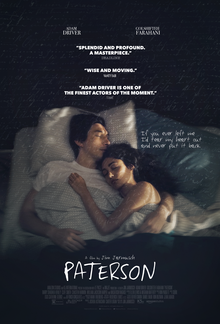Paterson
A Movie Review
–Review by Teri Hyrkas
I love summer, but it does get wild and crazy at times. Is your psyche suffering sunstroke from summer activities? Let me suggest a remedy: the movie Paterson. Written and directed by Jim Jarmusch, this singularly beautiful film, released in 2016, is an oasis for a parched soul.
Shot in the quiet, well-worn, blue collar city of Paterson, New Jersey, the movie depicts a city bus driver, also named Paterson, who is a poet. The storyline unfolds over the course of one week. The pace of the movie is unhurried. The film is chockfull of humor, kindness and Paterson’s poetry, which appears on the screen whenever he is thinking about or writing a poem. All the poems in Paterson but one were written by present day poet, Ron Padgett.
Paterson (Adam Driver) and his wife, Laura (Golshifteh Farahani), live in a small house in a poor part of town that is walking distance from the bus terminal. Paterson is a man of regimented habits; he wakes up at the same time every day without an alarm, his neatly folded work clothes are at the ready on a bedside chair, and he writes in his poetry notebook each day at breakfast, while in his bus waiting for his shift to start, on his lunch break at Paterson Falls and at his basement workbench “office” at home in the evening. But Paterson keeps his writing persona under wraps from his co-workers and friends. Is this behavior an indicator of the age-old conflict between the working man and the artist? Or is Paterson simply an INFJ on the Myers-Briggs Type Personality Indicator? Whatever the reason, Paterson chooses to share his poetry only with his wife, who is a true fan and faithful encourager of his art.
As orderly as Paterson is, his wife, Laura, is a free spirited creative craft-person. Her life goal, which seems to change frequently, is to eventually become a country music star by means of a self-taught guitar course she bought from an online source. While Paterson is at work driving a city bus, Laura’s creative energies are directed toward inventing new decor for the house in which she and Paterson live. One of the delightful, on-going sight gags in the film is Laura’s ever expanding color treatment of their tiny home. Her inventive application of color and design eventually overflows to include the cupcakes she bakes for a local farmers’ market. The cupcakes are a hit with shoppers and her successful venture produces a financial coup which, in due course, sets up a pivotal moment in the movie.
The underlying story of the film involves William Carlos Williams, a poet and a physician of the middle twentieth century, whose works include a five-volume epic poem about Paterson, NJ. Bus driver Paterson is a huge fan of Williams’ poetry, and his own compositions reflect this. Throughout the movie there are numerous visual and auditory nods to William Carlos Williams’ approach to verse. In one sequence, Paterson is on his routine evening walk with Marvin, the family’s English bulldog, when the pair hear a rap spilling out of a laundromat. A young man is using the time he spends washing his clothes to compose and practice a rap lyric aloud. The rapper soon comes to a halt in his delivery. He expresses his frustration, then utters the line: “No ideas but in things. No ideas but in things,” as though refocusing his attention on what is important, then he resumes his rap. The phrase, “No idea but in things,” refers to William Carlos Williams’ rejection of archaic poetic styles based on grand ideas and myths. It was William’s conviction that modern poetry is meant to do something completely new in a form that is direct, spare, quick. At the laundromat, the dog, Marvin, is captivated by the rapper’s performance. He sits in the laundromat’s doorway, stares at the young man and listens appreciatively to his recitation. Paterson himself is too polite to stare at anybody and stops short of the laundromat’s open door. He makes sure that he is hidden from the rapper’s view — although the leash connected to Marvin’s collar attests that someone is there — and he, along with Marvin, happily eavesdrop on the rapper’s delivery.
In the scene described above it is obvious that Paterson is hiding, but there is plenty of hiding in Paterson that is not obvious. There are hidden dreams, hidden worries, hidden courage, and hidden callings to name a few; even Marvin is hiding a few things. Many scenes in Paterson are shot in half-light or shadow, keeping faces and spaces obscured. In life, people may intentionally keep things hidden believing that is the only way to keep them safe. But what if this attempt at safety fails? What happens if the things one means to protect are misplaced, or worse, are destroyed?
One of the foremost gifts poets share with the world is their ability to move hidden things out of darkness and into light. For the poet William Carlos Williams, it’s ordinary things that he wants to show clearly. Common objects, people and events are, in William’s eyes, lifelines of beauty, truth and goodness and they deserve to be noticed.
Despite the many instances of hiddenness in the movie, Paterson is defined by a gracious and positive framework, including lighthearted humor, an attitude of thankfulness, an aura of innocence, and various acts of redemption. These attributes are what make Paterson so refreshing and restorative. I hope you will find some time this summer to rest and relax with Paterson.
Paterson is available on YouTube, Google Play, VuDu and iTunes. Paterson is presently free for viewing to Amazon Prime members.

